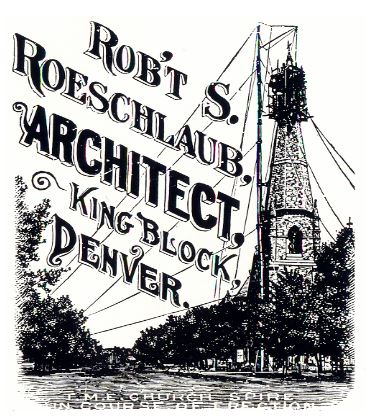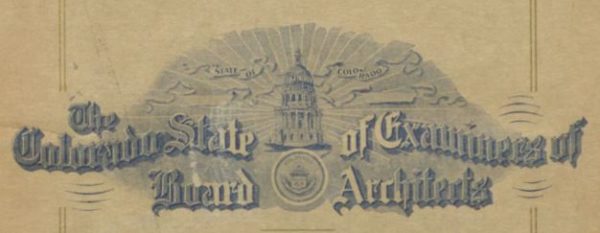On April 26, 1909, the Colorado Legislature passed a law requiring architects to be licensed in order to practice in the state of Colorado. In his 1909 Biennial Message Governor Henry Buchtel urged passage of the law in order “to raise the business of the selection and use of materials, and the superintendence of the construction of buildings, to the standard of a profession, and to guard against the employment of incompetent and unfit persons as architects.”
Colorado architect license number 1 went to Robert Roeschlaub, whose most famous buildings include the Central City Opera House and Denver’s Trinity Methodist Church. Roeschlaub also designed a number of school buildings in Denver, including the Emerson School, the Corona (now Dora Moore) School, and the now-demolished original Denver (East) High School, which stood at 18th and Stout. A biography of  Roeschlaub can be found in Colorado Heritage (issue 1-2, 1983), available for checkout from our library. Frank Edbrooke, the architect who completed the State Capitol and designed the Colorado State Museum, along with many other famous Denver buildings like the Brown Palace Hotel, claimed license number 2.
Roeschlaub can be found in Colorado Heritage (issue 1-2, 1983), available for checkout from our library. Frank Edbrooke, the architect who completed the State Capitol and designed the Colorado State Museum, along with many other famous Denver buildings like the Brown Palace Hotel, claimed license number 2.
Because by 1909 there were already many accomplished architects who had long been practicing in Colorado, there were two types of licenses given: form A, which did not require an examination but was given based on professional merit and experience, and form B, awarded upon passage of an examination. The Colorado State Board of Examiners of Architects was created in order to oversee the examining and licensing of architects. Over the next ten years the board published a series of reports on the program. In addition to information the board’s activities, the reports — which have recently been digitized and made available online by our library — also contain lists of the licensed architects along with their license number and business address, making them an excellent resource for anyone researching a Colorado architect from that time period.
Although the initial series of reports ceased in 1919, the board did continue to publish rosters of architects in later decades, many of which can be checked out from our library. Researchers interested in a particular historic architect should also see Architects of Colorado: Database of State Business Directory Listings 1875-1950, from the Colorado Historical Society. Their Architects of Colorado Biographical Series website is another excellent resource. The licensure board still exists today, and has been expanded to include the licensing of professional engineers and land surveyors. Current licensees can be found in the Colorado Department of Regulatory Agencies’ Licensee Lookup database.
The 1909 law also required any surplus funds to go to the architecture school at the University of Colorado. Today, the University of Colorado Denver has the state’s graduate school in architecture and planning. You can find many of their publications in our library. The university’s Boulder campus offers programs in architectural engineering and environmental design.

- How to Spot the Differences Between Eagles and Hawks - August 16, 2021
- How Transportation Projects Help Tell the Story of Colorado’s Past - August 9, 2021
- Time Machine Tuesday: The Night the Castlewood Canyon Dam Gave Way - August 3, 2021